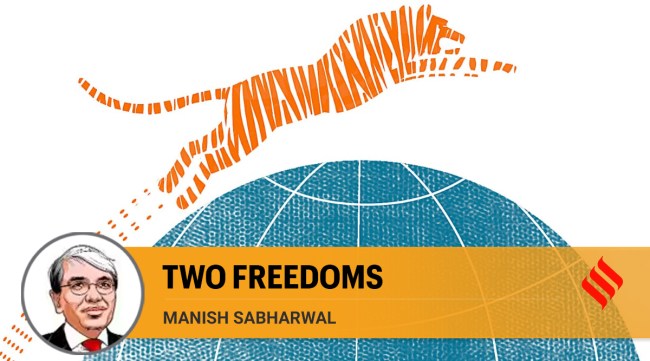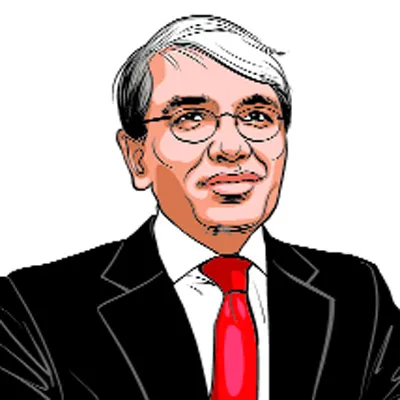Opinion G20 in India: Time to pounce on an opportunity
September's G20 meeting in Delhi is a logical milestone in India’s journey of combining democracy with prosperity.
 The next month’s G20 meeting in Delhi celebrates India building the world’s largest democracy on the infertile soil of the world’s most hierarchical society. (Illustration by CR Sasikumar)
The next month’s G20 meeting in Delhi celebrates India building the world’s largest democracy on the infertile soil of the world’s most hierarchical society. (Illustration by CR Sasikumar) Germans would describe the G7 becoming G20 as Zeitenwende, a historic turning point. Of course this expansion was not warmly welcomed by some G7 countries who are declining, ageing and anxious (descriptions of entitled, hypocritical and selfish are also used but unhelpful). But next month’s G20 meeting in Delhi celebrates India building the world’s largest democracy on the infertile soil of the world’s most hierarchical society. It also celebrates our expanding economic freedoms — formalisation, industrialisation, financialisation, urbanisation, and human capital — that will soon make India the world’s third-largest economy. Unlike China which forced its citizens to choose between their wallets and freedom, India is closer than ever to Gandhiji’s dream of combining mass democracy with mass prosperity.
The Bandung Conference in 1955 was interesting because the 29 leaders represented 54 per cent of the world’s population. But the G20 meeting is important because they represent 85 per cent of the world’s GDP. Despite India’s marvellous decision to grant universal franchise at birth, our global importance floundered for decades after 1947 because economic power precedes geopolitical, military and soft power. It shamefully took 72 years for 1.3 billion Indians to cross the GDP of 63 million British. Why?
India’s post-1947 economic policy choices not only distorted the relative roles of samaj, bazaar and sarkar but failed to distinguish between the list of ingredients (the what) and the recipe (the how of proportioning, sequencing, influencing, prioritising and taking on vested interests). Flagship lists — the 10-point programme of 1967, 13-point program (1977), and 20-point programme (1975) — preceded an eight-point programme for altering socio-economic attitudes, five-point programme for urban renewal, and a four-point programme for regional imbalances. These lists feel like a victim of an enemy they couldn’t see, didn’t understand, and didn’t want to overpower. Consequently, they chose soundbites over strategy, planning over entrepreneurship, and public over private.
Economic policy pursued what they describe in my birthplace J&K as moolan droth ta patran sag — watering the leaves and cutting the roots. But in the last decade, India has grown from the world’s 10th largest economy to the fifth. How? We executed a new economic recipe that believed there are no poor people, only people in poor places. Some places are geographic (states, cities and villages) and some are conceptual (cities, sectors, and skills) but all benefit from higher productivity. Reforms included formalisation (moving from deals to rules), GST, bankruptcy, demonetisation, DBT, digital payments, digital public infrastructure, inflation targeting, foreign investment, roads, apprentice, decriminalisation, National Education Policy, and much else.
A radical economic reform agenda is understandably controversial, inevitably tricky, and never perfect. GST could have started simpler, demonetisation could have anticipated retail banker-enabled whitewashing, skilling could have targeted apprenticeships, and ease-of-doing-business could have targeted employer compliance. But policy-making, like life, is not the art of avoiding mistakes but iteratively making progress. Recent moves on Degree Apprentices, Jan Vishwas Bill, and Rs 2,000 note withdrawal represent iterative learning.
These reforms make imagining India’s $10-trillion economy possible: Twenty per cent of our labour force works on farms. We have 200 cities with over a million people (we have 52 today). Our cities meet the Marchetti constant (most people have a 30-minute commute). Our government borrows at less than 4 per cent. Aadhaar-linked land markets equalise rental yields and mortgage borrowing rates. Our credit-to-GDP ratio is 100 per cent. Corporate income taxpayers equal 50 per cent of GST registrants, and individual income taxpayers equal 25 per cent of the population. We only have 25 central ministries (more than 50 today). Education and employability have converged, taking our gross enrollment ratio to 50 per cent.
Three-quarters of our labour force has social security. Government school enrollment goes back to 70 per cent. Foreign investors already buy this economic possibility; 50 per cent of FDI since 1947 has come in the last five years. India’s economic complexity is rising: Economists suggest development is like a game of scrabble where government provides vowels and entrepreneurs provide consonants. Reforms to three missing vowels that retard massive high-wage, non-farm job creation — labour laws, performance management for 25 million civil servants, and a speedy court system — are currently blocked by vested interests and must be overruled.
Inevitable around the G20 meeting will be some articulate offshore diaspora indulging in what author Martin Amis calls “one-downmanship” and competitive negativity. This grumbling will echo the Hindu Rate of Growth (the soft bigotry of low expectations or racism given India’s growth acceleration happened without shooting all its Hindus), “Why India can’t replace China”, “America’s bad bet on India”, and “I am losing hope on India”. Nobody grudges offshore Indians or their ancestors choosing exit over voice or loyalty — Albert Hirschman’s superb framework about the three possible individual responses to country decline — because the post-1947 economic environment was hostile to intelligence, talent, and hard work. Also, pessimists feel wiser because they sound like they are protecting you, while optimists sound like we are selling you something. But India is genuinely changing. I request India’s diaspora to give us a few more years. Even better, help by moving back.
Exactly 100 years ago, Maulana Azad said, “The civil disobedience movement has changed the Indian mentality and brought the message of liberty to every individual.” Azad recognised the freedom movement shifted from an elite “un-British” rule pitch to the colonial state by early nationalists to a mass political movement that talked to people, catalysed new bonds and championed Indian alternatives. Indian Ideas of Freedom by Dennis Dalton suggests the ideas of seven important Indian thinkers for pursuing political freedom were original, individual and political, and drew heavily from indigenous cultural resources. Unlike our political ideas, India’s post-1947 economic ideas were simplistic, imitative, and confiscated freedom. Change began in 1991 but accelerated in the last decade, and next month’s G20 meeting is a logical milestone on India’s journey of combining two freedoms. Our time is coming but our turn has come. Let’s pounce on it.
The writer is co-founder of Teamlease Services





